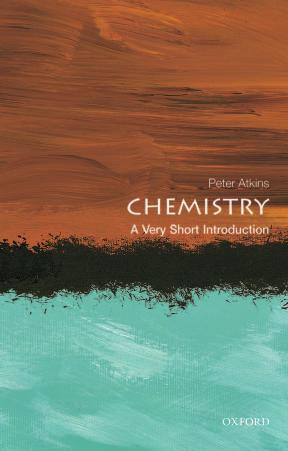Chemistry: A Very Short Introduction by Peter Atkins

Author:Peter Atkins
Language: eng
Format: epub, pdf
ISBN: 9780199683970
Publisher: OUP Oxford
Published: 2014-11-15T05:00:00+00:00
Radical reactions
The third kind of reaction takes place when radicals meet. You need to know that a radical (or ‘free radical’ ) is a molecule with an odd number of electrons. We have seen that electrons pair together when bonds form, so a radical is a molecule in which all the electrons except one have paired and hold the atoms together, and there remains one unpaired electron. A radical is commonly denoted R· or ·R, the dot representing the unpaired electron.
Most radicals are aggressively reactive and do not survive for long in the wild. In some cases, two radicals might collide, and clump together as their unpaired electrons pair and bind the two radicals together to form a conventional molecule with an even number of electrons: R· + ·R → R–R. This kind of process occurs in flames, which are environments rich in radicals because the stress of high temperatures rips molecules apart, sundering the electron-pair bonds. Indeed, one form of fire-retardant is a substance that gives rise to radicals when heated. These radicals, lets denote them ·X, latch on to the radicals that are propagating the flame and quench their chemical aggressiveness, R· + ·X → R–X, so that the flame peters out.
Other radicals are of great commercial importance, for they are involved in the formation of many plastics. The general idea behind this process, which is called polymerization, is that when a radical R· attacks an ordinary molecule M it might attach to it. However, the outcome is again a molecule, now RM·, with an odd number of electrons, so it is also a radical. That radical can go on to attack another M molecule and attach to it. The result is still a radical, now RMM·. In other words, there can be a chain reaction, a chain of processes that propagates indefinitely, to give a long snaking RMM … M· radical, or until two such radicals collide, stick together by electron pairing, and so terminate the chain.
Those ubiquitous plastics polythene (polyethylene), polystyrene, and PVC (polyvinyl chloride) are made in this way. In the case of polythene the molecule M, which in this context is called a monomer, is ethylene, H2C=CH2. The outcome of the polymerization is a long chain, a polymer, of hundreds of –CH2CH2– units. Chemists have found that by starting with different versions of ethylene, such as H2C=CHX, where X can be a group of atoms, they can form polymers with a wide range of properties. Thus, when X is a benzene ring, the polymer is polystyrene and when X is a chlorine atom the polymer is PVC. To obtain the non-stick Teflon® all the hydrogen atoms are replaced by fluorine atoms; that is why its more formal name is polytetrafluoroethylene (PTFE).
Download
Chemistry: A Very Short Introduction by Peter Atkins.pdf
This site does not store any files on its server. We only index and link to content provided by other sites. Please contact the content providers to delete copyright contents if any and email us, we'll remove relevant links or contents immediately.
Alchemy and Alchemists by C. J. S. Thompson(3305)
The Elements by Theodore Gray(2859)
The Club by A.L. Brooks(2759)
How to Make Your Own Soap by Sally Hornsey(2752)
Drugs Unlimited by Mike Power(2490)
Wheels of Life by Anodea Judith(1927)
Cracking the Sat French Subject Test, 2013-2014 Edition by The Princeton Review(1774)
Perfume by Jean-Claude Ellena(1743)
The Flavor Matrix by James Briscione(1723)
Cracking the LSAT, 2012 Edition by Princeton Review(1700)
The Cosmic Machine: The Science That Runs Our Universe and the Story Behind It by Scott Bembenek(1694)
MCAT Physics and Math Review by Princeton Review(1571)
1000 Multiple-Choice Questions in Organic Chemistry by Organic Chemistry Academy(1570)
The Thing Around Your Neck by Chimamanda Ngozi Adichie(1496)
Handbook of Modern Sensors by Jacob Fraden(1482)
Cracking the SAT Premium Edition with 6 Practice Tests, 2017 by Princeton Review(1481)
Synchrotron Light Sources and Free-Electron Lasers by Eberhard J. Jaeschke Shaukat Khan Jochen R. Schneider & Jerome B. Hastings(1461)
A is for Arsenic: The Poisons of Agatha Christie (Bloomsbury Sigma) by Kathryn Harkup(1460)
Harry Potter All Books: 8 Books by J.k.rowling(1439)
